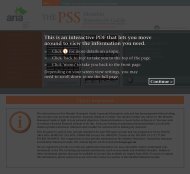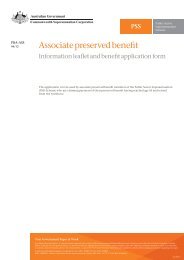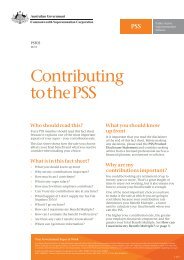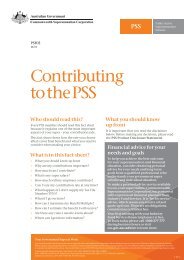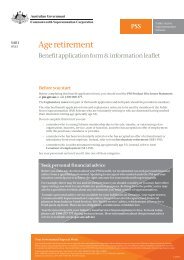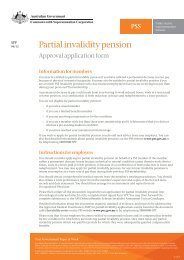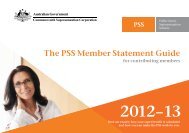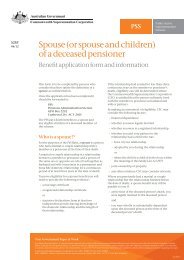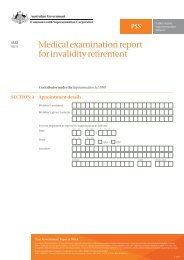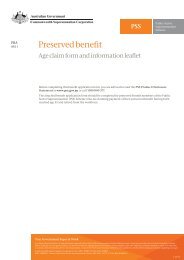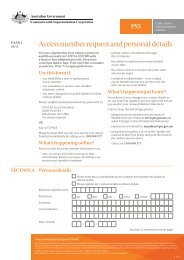Product Disclosure Statement - PSS
Product Disclosure Statement - PSS
Product Disclosure Statement - PSS
You also want an ePaper? Increase the reach of your titles
YUMPU automatically turns print PDFs into web optimized ePapers that Google loves.
7. How super is taxed<br />
Super can be taxed in three ways:<br />
> > contributions going into a fund can be taxed<br />
> > investment earnings of a fund can be taxed, and<br />
> > tax may be payable on the benefits you receive from<br />
a fund.<br />
Tax on contributions<br />
Member contributions paid to the <strong>PSS</strong> are paid from<br />
your after-tax income and are generally not subject to<br />
contributions tax. These contributions are known as<br />
‘non concessional contributions’ for tax purposes.<br />
Employer productivity contributions are taxed at 15%—<br />
tax is deducted from the contributions when we receive<br />
them from your employer. These contributions are<br />
known as ‘concessional contributions’ for tax purposes.<br />
Transfers from other funds into the <strong>PSS</strong> will not be<br />
taxed at the time of the rollover, except where the<br />
rollover contains an untaxed component, which will<br />
be taxed at 15%.<br />
Additional tax may be payable if you make<br />
contributions in excess of the caps on<br />
non-concessional and concessional contributions.<br />
For more information refer to the Tax and your<br />
<strong>PSS</strong> super booklet available on our website.<br />
Tax on fund earnings<br />
Investment earnings of the fund are taxed at concessional<br />
rates as the <strong>PSS</strong> is a complying superannuation fund.<br />
Earnings are taxed at a concessional tax rate of 15%.<br />
The effective rate of tax incurred may actually be less than<br />
this because superannuation funds receive capital gains tax<br />
discount on some capital gains as well as franking credits.<br />
Tax on benefits<br />
Tax may be payable when you receive a benefit from the<br />
fund. The amount of tax payable on your benefit will<br />
depend on factors such as your age, the type of benefit,<br />
whether the benefit is sourced from contributions paid<br />
into the <strong>PSS</strong> and earnings on those contributions (taxed<br />
source) or from other sources (untaxed source).<br />
Benefits can be paid as a lump sum, pension or a combination<br />
of both. You will need to refer to the Tax and your <strong>PSS</strong> super<br />
booklet for more information on the rate of tax payable,<br />
as the rate of tax payable depends on many factors.<br />
You should supply your Tax File Number as part<br />
of investing in the <strong>PSS</strong>.<br />
Tax file number (TFN)<br />
We are authorised to collect your TFN under the<br />
Superannuation Industry (Supervision) Act 1993. You do not<br />
have to supply it, but if you do not give us your TFN:<br />
> > benefits paid to you may be subject to a higher<br />
rate of tax (if you later supply your TFN, you may<br />
reclaim the additional tax from the Australian<br />
Taxation Office)<br />
> > we will not be permitted to accept contributions for<br />
you (other than employer contributions), and<br />
> > your employer contributions will be taxed at a higher<br />
rate— although a refund may be available on the extra<br />
tax paid after you supply the TFN, and<br />
> > it will be more difficult for us to identify your<br />
superannuation accounts.<br />
Tax in super is very complex and subject to change<br />
from time to time. This section of the PDS is only<br />
intended to provide a summary about the tax<br />
implications of super. We recommend that you seek<br />
advice from a licensed professional and refer to the<br />
ATO website www.ato.gov.au.<br />
You should read the important information about<br />
tax and your <strong>PSS</strong> super before making a decision. Go<br />
to the Tax and your <strong>PSS</strong> super booklet available at<br />
www.pss.gov.au/pds. The material relating to tax<br />
may change between the time when you read this<br />
<strong>Statement</strong> and the day when you acquire the product.<br />
8. Insurance in your super<br />
Death and invalidity cover can help protect your current<br />
lifestyle and provide for you or your family in the event of<br />
sickness, injury or death. The <strong>PSS</strong> offers partial invalidity,<br />
permanent invalidity and death cover at no extra cost.<br />
You are automatically covered with these types of<br />
cover – you do not need to apply, and you cannot opt<br />
out or change your level of cover. Additional death and<br />
invalidity cover is also available at a relatively low cost<br />
for contributing members who are unable to reach their<br />
Maximum Benefit Limit (MBL).<br />
Death and permanent invalidity cover<br />
There are no costs associated with the default level of<br />
cover. Your benefit is based on your entitlement had you<br />
worked to age 60. Benefits for contributing members after<br />
reaching age 60 are based on the age retirement pension<br />
that would have been payable.<br />
Cover is subject to an assessment of pre-existing medical<br />
conditions and not being classified as a limited benefits<br />
member. Cover for preserved and associate members is based<br />
on the value of the preserved entitlement at the date of claim.<br />
The calculation of an invalidity retirement benefit<br />
for contributing members depends on a number of<br />
factors, including:<br />
> > your Final Average Salary<br />
> > your Accrued Benefit Multiple at retirement<br />
> > a multiple based on what would have accrued had<br />
contributions continued to age 60, at the greater of<br />
5% or the average percentage rate contributed over<br />
the 78 pay days (total pay days, if less) prior to the date<br />
of invalidity retirement or death<br />
> > the Maximum Benefit Limit, and<br />
> > whether you have been classified as a limited or full<br />
benefits member.<br />
New members (regardless of prior membership) are required<br />
to complete a Confidential Medical and Personal <strong>Statement</strong><br />
(CMAPS), and lodge it with their personnel section within<br />
14 days of starting membership. Members will be classified<br />
as a limited benefits member for three years of membership<br />
Your Government Super at Work 7 of 8



